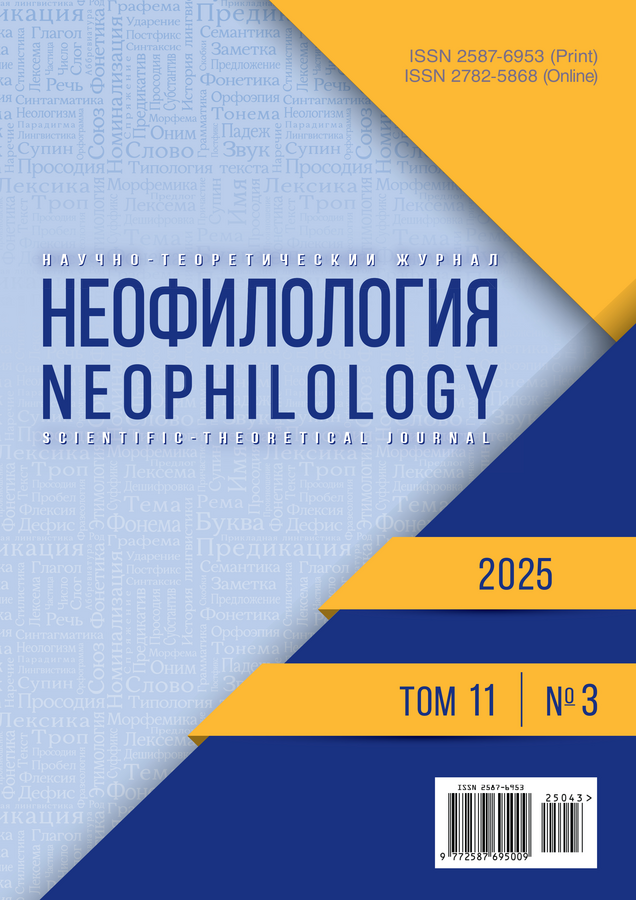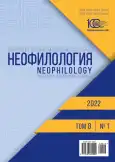Трансформация библейских, мифологических и фольклорных моделей в «Трёх сказках о Змие крылатом, трёхголовом, огнедышащем» Радия Погодина
- Авторы: Елепова М.Ю.1, Кабанова Н.Г.1
-
Учреждения:
- ФГАОУ ВО «Северный (Арктический) федеральный университет им. М.В. Ломоносова»
- Выпуск: Том 8, № 1 (2022)
- Страницы: 118-127
- Раздел: РУССКАЯ ЛИТЕРАТУРА И ЛИТЕРАТУРЫ НАРОДОВ РОССИЙСКОЙ ФЕДЕРАЦИИ
- URL: https://journal-vniispk.ru/2587-6953/article/view/301830
- DOI: https://doi.org/10.20310/2587-6953-2022-8-1-118-127
- ID: 301830
Цитировать
Полный текст
Аннотация
Современная сказка является продолжательницей традиций предшествующих сказок нести добро, поучать и развлекать, но уже через трансформацию библейских, мифологических и фольклорных моделей, призму авторского опыта и его жизненной позиции. Предложен новый взгляд на мифопоэтическое пространство «Трёх сказок о Змие крылатом, трёхголовом, огнедышащем» Радия Погодина (1989) через их целостный анализ, выявление их мифопоэтической специфики и художественного своеобразия. Осмысление особенностей архетипического сюжета, мифоритуального подтекста произведения, системы персонажей сказок, их интертекстуальных связей позволяют выявить глубокие содержательные пласты рассматриваемого сочинения. Сказки, наполненные мифологической архаикой, легко вбирают в себя современные реалии, так что художественный мир литературных сказок Р. Погодина представляет собой единство древних архетипических моделей с обновляющимися, подчас остро актуальными мотивами. Система мифологем и бинарных оппозиций, мифологические аллегории и аллюзии формируют авторскую модель мира. Мифопоэтические сюжетные зарисовки и архетипические первообразы в значительной степени обусловливают смысловую многозначность и художественную сложность сказок Р. Погодина. Произведение Р. Погодина, являясь потомком сказки народной, продолжает и развивает её жанровые особенности, заставляя воспринимать сказочное чудо как часть нашей жизни в её обыденных деталях и подробностях. Центральный сказочный образ – Змий благодаря своей многоликости и неоднозначности становится воплощением библейских, фольклорных и мифологических мотивов, заставляющих направить взгляд человека в глубь своей души. Смысловая многозначность и художественная сложность произведения позволяет предполагать обращённость его к разновозрастной читательской аудитории.
Об авторах
М. Ю. Елепова
ФГАОУ ВО «Северный (Арктический) федеральный университет им. М.В. Ломоносова»
Email: m.elepova@yandex.ru
ORCID iD: 0000-0002-7229-5851
доктор филологических наук, профессор кафедры литературы
Россия, 163002, Российская Федерация, г. Архангельск, набережная Северной Двины, 17Н. Г. Кабанова
ФГАОУ ВО «Северный (Арктический) федеральный университет им. М.В. Ломоносова»
Автор, ответственный за переписку.
Email: nataliakabanova30@gmail.com
ORCID iD: 0000-0001-8624-3481
аспирант, кафедра литературы
Россия, 163002, Российская Федерация, г. Архангельск, набережная Северной Двины, 17Список литературы
- Пропп В.Я. Морфология волшебной сказки. М.: Знание, 1998. 345 с.
- Афанасьев А.Н. Народные русские сказки. М.: Худ. лит., 1957. 571 с.
- Мелетинский Е.М. Герой волшебной сказки. Происхождение образа. М.: Наука, 1958. 240 с.
- Неёлов Е. «Сказка – это архисерьёзно» / Н. Турчинская. «Вести – Карелия. События недели». Электрон. ст. Петрозаводск, 2007. URL: http://petrozavodsk.rfn.ru/rnews.html?id=4153 (дата обращения: 14.04.2021).
- Погодин Р. Земля имеет форму репы: Сказки / рис. и оформл. А. Флоренского. Л.: Дет. лит., 1989. 207 с.
- Аникин В.П. Русское устное народное творчество. М.: Высш. шк., 2001. 726 с.
- Иванов В.В., Топоров В.Н. Змей Горыныч // Мифологический словарь / гл. ред. Е.М. Мелетинский. М.: Сов. энцикл., 1991. 736 с.
- Лупанова Н.И. Гофман и его сказка // Литература. 1998. № 7. С. 9-17.
- Булгаков М.А. Мастер и Маргарита. СПб.: Лениздат, 2014. 511 с.
- Зеленин Д.К. Тотемический культ деревьев у русских и у белорусов // Известия АН СССР. Серия 7. Отделение общественных наук. 1933. № 6. С. 591-629.
Дополнительные файлы











